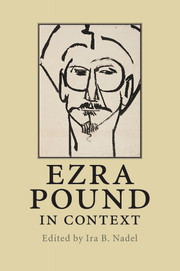Book contents
- Frontmatter
- Contents
- Notes on contributors
- Acknowledgements
- Chronology
- List of abbreviations and note on references to The Cantos
- Introduction
- Part I Biography and works
- Part II Historical and cultural context
- 16 The classics
- 17 Provençal and the troubadours
- 18 Dante and early Italian poetry
- 19 America
- 20 Venice
- 21 London
- 22 Paris
- 23 Rapallo and Rome
- 24 Pisa
- 25 Imagism
- 26 Vorticism
- 27 Music
- 28 Visual arts
- 29 Confucius
- 30 The Orient
- 31 Little magazines
- 32 Publishing and publishers
- 33 Modernism
- 34 Fascism
- 35 Anti-Semitism
- 36 Gender and sexuality
- 37 Race
- 38 Travel
- Part III Critical reception
- Further reading
- Index
25 - Imagism
Published online by Cambridge University Press: 05 July 2014
- Frontmatter
- Contents
- Notes on contributors
- Acknowledgements
- Chronology
- List of abbreviations and note on references to The Cantos
- Introduction
- Part I Biography and works
- Part II Historical and cultural context
- 16 The classics
- 17 Provençal and the troubadours
- 18 Dante and early Italian poetry
- 19 America
- 20 Venice
- 21 London
- 22 Paris
- 23 Rapallo and Rome
- 24 Pisa
- 25 Imagism
- 26 Vorticism
- 27 Music
- 28 Visual arts
- 29 Confucius
- 30 The Orient
- 31 Little magazines
- 32 Publishing and publishers
- 33 Modernism
- 34 Fascism
- 35 Anti-Semitism
- 36 Gender and sexuality
- 37 Race
- 38 Travel
- Part III Critical reception
- Further reading
- Index
Summary
What did imagism do for Pound and what, in turn, did Pound do for imagism? The answers yield “a language to think in” (LE, 194) regarding Pound's emphasis on precision as a means of carving distinctions between terms. That process, an ethical end-in-itself, also delineates components of a Poundian model culture.
Imagism originated in the tea room of the British Museum. Or so its narrative would have it. In the fall of 1912, Pound read H.D.'s poem, “Hermes of the Ways,” there in the company of H.D. and Richard Aldington. After making changes, Pound rapidly wrote “H.D. Imagiste” at the bottom of the typed sheet now slashed with his pencil marks, according to H.D. in her memoir, End to Torment. Of course, imagism was not a whimsical inspiration. Pound had been led to this concept through his study of Arnaut Daniel, Cavalcanti, and Dante, writers of precision and detail. He had actually formulated the term “imagist” when reworking the proofs of Ripostes in the spring of 1912. By 1914, his anthology Des Imagistes appeared, soon challenged by Amy Lowell's fuller and competitive anthology, Some Imagist Poets (1915). The politics of the movement soon overtook the quality of the poetry and Pound turned elsewhere.
But precisely because Pound transcended imagism, it plots horizon points for marking Pound’s development. A poet wed to imagism necessarily focuses on “small things,” risking confinement to “a poetic of stasis.” Yet by presenting at one moment multiple matters arranged in interactive “complexes”; by creating illusions of “freedom from time and space limits” (LE, 4); this small static aesthetic set the course for the modernist long poem.
- Type
- Chapter
- Information
- Ezra Pound in Context , pp. 274 - 284Publisher: Cambridge University PressPrint publication year: 2010

